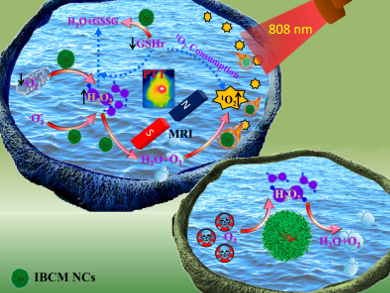Reactive oxygen species (ROS) levels in cells can be used to destroy cancer cells, but care must be taken to minimize harm to healthy cells. The selective regulation of ROS levels with enzyme-like nanoparticles could allow this.
Mengchao Zhang, Jilin University, China, Xiue Jiang, Chinese Academy of Sciences, Jilin, China, and colleagues have prepared a multienzyme-like nanocomposite (IBCM NC) via a facile one‐step biomineralization. IBCM NC consists of indocyanine green (ICG), bovine serum albumin (BSA), and cerium-manganese oxide. The team combined BSA, ICG, Ce(NO3)3, MnCl2, and NaOH in solution to prepare the nanocomposite.
IBCM NC functionally mimics the enzymes superoxide dismutase and catalase. It can be used to regulate superoxide, hydrogen peroxide, and oxygen levels in cancer cells and to reduce glutathione levels. Glutathione usually acts as an antioxidant and lowers ROS levels.
This control of ROS levels results in a phototherapeutic effect under irradiation with near-infrared light. It also provides contrast for magnetic resonance imaging (MRI). On the other hand, IBCM NC can reduce the levels of superoxide and hydrogen peroxide in normal cells to protect them against ROS damage.
- Multienzyme-Mimicking Nanocomposite for Tumor Phototheranostics and Normal Cell Protection,
Wenyao Zhen, Wei Wang, Zhifang Ma, Jing Bai, Xiaodan Jia, Yudi Ruan, Chao Wang, Mengchao Zhang, Xiue Jiang,
ChemNanoMat 2018.
https://doi.org/10.1002/cnma.201800397




